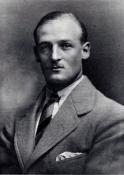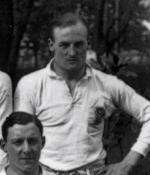
|
The King's School Canterbury |
Roll of Honour |
| Surgeon James Henry Digby WATSON MB CHB RN | |
|
HMS Hawke Royal Navy Date of birth: 31st August 1890 Date of death: 15th October 1914 Killed in action aged 24 Commemorated on the Chatham Naval Memorial Panel 1 |

|
| He was born at Southsea on the 31st of August 1890, the son of Engineer Captain James Herbert Watson RN and Eliza Viets (nee Smith) Watson of 'Westwood', Helensburgh, Scotland. He was educated at the Junior King's School from September 1899 and the King's School Canterbury from January 1904 to April 1906, playing for the Rugby XV in 1905. He then moved to Scotland where he completed his education at Edinburgh Academy from July 1906 to 1908, playing rugby for the First XV at centre and winning the high jump in each of the years he was there. At the Academy he acquired the nickname of "Bunjy" by asking for a rubber in the usual slang of King's which was unheard of in Edinburgh. He then proceeded to Edinburgh University from the 1st of May 1908 to 1913 to study medicine. In 1913 he achieved MB and ChB and played for the University First XV, as well as winning the University Middleweight Boxing Championship and representing Scotland against Ireland at the long jump in 1912 which he won with a jump of 22 feet, 9 and half inches. He joined Edinburgh Academicals Club as a centre three-quarter and became their captain in 1912/13. At Christmas 1911 he was invited to tour Wales with the Barbarians at Christmas 1911 in which they lost both matches. He was played with them again in a match against Leicester on the 30th of December 1912 losing by 15 points to 11. He was selected as a reserve centre for Scotland in 1912/13 but was never capped. In 1913 he toured again with the Barbarians on their Easter tour of Wales but again lost both matches. He moved to London to complete his medical studies and played rugby for both Blackheath and the London Hospital. On the 6th of December 1913 he represented the South of England. In early 1914 he was selected by England at centre and made his debut at Twickenham against Wales on the 27th of January which England won by 10 points to 9. He was selected for the following match, against Ireland on February the 14th, but missed it due to an injury he picked up playing for Blackheath against Liverpool. He next appeared against Scotland at Inverleith on the 21st of March which England won by 16 points to 15. On April the 13th he played for England for the last time scoring a try in the 39 point to 13 victory at Stade de Colombes and clinching England's second successive Grand Slam. In August 1914 he was appointed a Surgeon in the Royal Navy and was posted to HMS Hawke. HMS Hawke was an old armoured cruiser operating as part of the 10th Cruiser Squadron assigned to the Northern Patrol. She had originally been launched at Chatham in 1891 and was one of the oldest ships still in service. HMS Hawke was being used as a training ship and had many young cadets on board. She had been recommissioned in February 1913 with a nucleus crew and had come up to her full complement on the outbreak of war in August 1914. During September 1914, she had visited Lerwick. On the 15th of October 1914 she was sixty miles off Aberdeen with another cruiser, HMS Theseus when they were attacked. They were operating on without a destroyer screen as submarine attack was not yet commonplace. HMS Hawke had just turned to intercept a neutral Norwegian collier when the German U Boat U9 under Kapitanleutnant Otto Weddingen launched a torpedo at Theseus. The missile missed Theseus and struck HMS Hawke amidships near her magazine the detonation of which was followed by a terrific explosion as the magazine exploded. The detonation was followed by a second terrific explosion, in which a large number of the crew was killed. The ship sank within 8 minutes and was only able to launch one ship's boat. Five hundred and twenty five perished, only the 49 men in the long boat were saved. They were picked up 3 hours later by a Norwegian steamer. HMS Theseus was under strict Admiralty orders not to attempt to pick up survivors, as only several weeks earlier there had been a disaster. A witness on board U9 recorded the following:- "I gazed at the little picture of the upper ocean. The distant three cruisers were some wide space apart, but were converging, and were steering for a point and that point was apparently in the vicinity where we lay. No wonder the Commander thought they must want a torpedo. "We imagined they were bent on joining forces and steaming together, but it presently became apparent that they intended to exchange signals, drop a cutter in the water, and deliver mail or orders, and then go their respective ways. We steered at full speed for the point toward which they were heading, our periscope showing only for a few moments at a time. The Cruisers, big armoured fellows, came zigzagging. We picked one, which afterward turned out to be HMS Hawke, and maneuvered for a shot. "It was tricky work. She nearly ran us down. We had to dive deeper and let her pass over us; else we would have been rammed. Now we were in a position for a stern shot at an angle, but she turned. It was a fatal turning, for it gave us an opportunity to swing around for a clear bow shot at 400 metres. "Second bow tube fire!" Weddingen snapped out the order, and soon there sounded the tell-tale detonation. "We dived beyond periscope depth, ran underwater for a short distance, and then came up for a look through our tall, mast-like eye. The Hawke had already disappeared. She sank in eight minutes. Only one boat was in the water. It was the mail dory that had been lowered before the torpedo explosion. At the rudder the boat officer hoisted a distress signal on the boat's staff. That little dory with half a dozen men aboard was all that was left of the proud warship." He is commemorated on a stone tablet at St Michaels Church in Helensburgh, on the Helensburgh war memorial, on the Rugby Football Union war memorial at Twickenham and on the memorial at Blackheath Football Club. |
|
 | |
Back